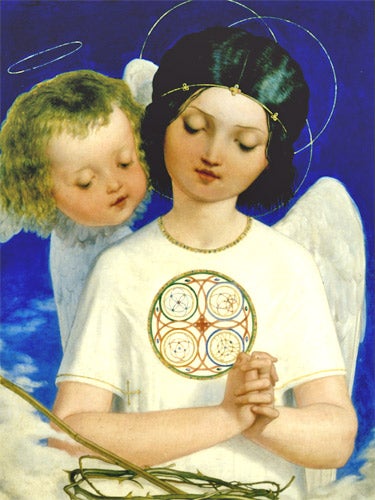The Madox Brown angels who went missing for a century
The work was completed in 1847 on the artist's return to London after a stay in Rome and the death of his first wife

Two angels stare lovingly at a crown of thorns, their peaceful composure at odds with the turbulent story of the work itself, which has not been seen in public for more than a century.
British painter Ford Madox Brown, one of the most important figures in the Pre-Raphaelite art movement, produced The Seraph's Watch in 1847. It was last exhibited publicly in 1896, after which time its whereabouts were unknown to art historians.
Now Julian Treuherz, the curator of a new exhibition of Madox Brown's work, has discovered the painting in a private collection. Ford Madox Brown: Pre-Raphaelite opens at Manchester Art Gallery next month, the first major retrospective of the artist's work in more than 50 years.
"I was very excited when it re-appeared, having known it only from a copy made later," said Treuherz.
According to Mr Treuherz, The Seraph's Watch was finished shortly after Madox Brown completed a 10-month trip to Rome, a period which coincided with the fatal illness of his wife, Elizabeth. After her death he moved to Kensington, London, where he completed the painting.
Madox Brown's pupil, Dante Gabriel Rossetti, one of the Pre-Raphaelite movement's founders, made a copy of the painting two years after its production. Rossetti's copy has since enjoyed a higher profile than the original, selling at auction at Sotheby's in 2006 for £100,000.
Mr Treuherz said The Seraph's Watch was first shown at an 1847 exhibition at the British Institution for Promoting Fine Arts, in London.
"It was sold to a Mr Cook or Cock and then it disappeared," he explained. "The next time it was shown in public was at the 1896 exhibition of the Arts and Crafts Exhibition Society in London, a few years after the artist's death in 1893."
Mr Treuherz discovered the painting when he made contact with Robert Holden, a London art adviser, who helped to orchestrate its loan.
The exhibition also features a previously unknown preparatory study for Madox Brown's The Last of England, one of the painter's most famous works, which shows a couple migrating from Britain to make a new life abroad.
Such trips were common during the artist's lifetime. From 1820 onwards around 10 million Britons left for the colonies and America.
The study, which differs subtly from the finished work, has not been seen in public since 1865.
The artist
* Ford Madox Brown was born to British parents in Calais in 1821. He spent much of his youth in France and Belgium before training to be an artist at the academies of Bruges, Ghent and Antwerp between 1835 and 1839.
* One of his most influential periods came during 1845-46, when he went to Italy via Basel where he saw the work of Hans Holbein, and came into contact with the Nazerenes, German painters.
* He returned to England in 1846, and became friends with younger artists including Dante Gabriel Rossetti and William Holman Hunt who formed the Pre-Raphaelite Brotherhood in 1848.
* He died as a result of complications from gout on 6 October 1893.
Join our commenting forum
Join thought-provoking conversations, follow other Independent readers and see their replies
0Comments